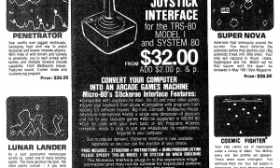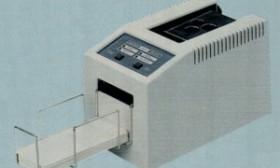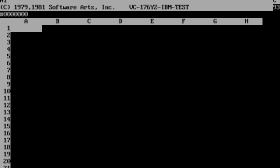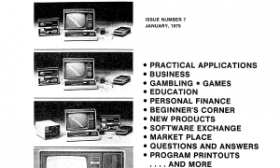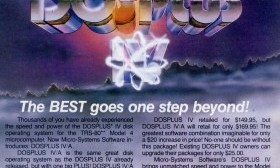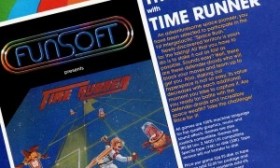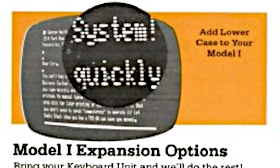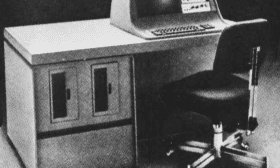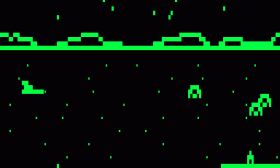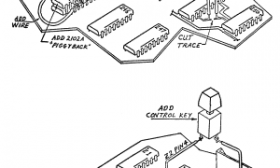The Stickeroo Joystick Interface was an Atari-style joystick interface for the TRS-80 Model I and System 80 computers. Introduced in 1982, the Stickeroo was sold by Micro-80, an Australian magazine dedicated to the TRS-80 and System 80. (The System 80 was nearly identical to the computer sold in the United States as the PMC-80.) The original advertisements also mentioned an upcoming TRS-80 Model III version of the Stickeroo, but that was presumably never produced.
The “Micro-80 Product Catalogue” was a multiple page section of Micro-80 that sold TRS-80 and System 80 hardware and software by mail-order to “customers throughout the Australian and Pacific region.” Many of the products were imported from the United States, but others, including the Stickeroo Joystick Interface, were products of Australia.
(Read more...)
The Radio Shack CR-510 Card Reader was introduced in 1984 at a cost of $1595.00. Aimed primarily at schools, it appeared in the Radio Shack catalog under the headline “Automate Time-Consuming Tasks with a TRS-80 Computer Card Reader.”
Administrators, teachers, and students can benefit from this new TRS-80 input device. Automate data compilation, evaluate surveys and polls, or correct multiple choice tests. The CR-510 provides single, demand, or continuous feed operation and is controlled through manual switches or software. Cards must be at least 6 inches in length and can be either marked or punched (with standard keypunch).
The CR-510 communicated through the RS-232 port, so it could connect to any TRS-80 computer. It came with 200 cards and a disk with sample drivers written in BASIC and COBOL. Those sample drivers must have been important when you consider that there was no software available for the CR-510!
(Read more...)
VisiCalc is one of the most important programs ever created for microcomputers. It was not only the first spreadsheet program but is also generally regarded as the first “killer app.” It was the top selling program for four years, selling more than 200,000 copies in its first two years alone. Its popularity helped to drive early personal computer sales; many people bought a personal computer just to use VisiCalc.
Dan Bricklin came up with the idea for an “electronic spreadsheet” while still a graduate student at Harvard Business School. He and Bob Frankston founded Software Arts, Inc. in 1979 to explore the idea and VisiCalc was the result.
First demonstrated at the National Computer Conference in June 1979, the Apple II version of VisiCalc was shipped on October 17, 1979. Although developed by Software Arts, VisiCalc was sold by Personal Software (later VisiCorp), a company founded in 1976 by Dan Fylstra and Peter Jennings.
VisiCalc for the Apple II was so successful that versions for other computers were inevitable. The initial targets were the Commodore PET, the Atari 800, and the TRS-80 Model I. The Commodore PET and the Atari 800 shared the same 6502 processor as the Apple II and could use the same VisiCalc code. But the TRS-80 version required converting the VisiCalc code to use the Z80 processor, a project undertaken by Seth Steinberg. Despite this, both the Atari 800 and TRS-80 versions were released in late 1980, almost a year after the release of the Apple II version.
(Read more...)
H&E Computronics, Inc. was well known for their line of business software for the TRS-80 and other computers, including programs such as VersaReceivables and VersaLedger. But they were probably best known for their TRS-80 monthly magazine, which billed itself as “the original magazine for TRS-80 owners.” It was called by a number of different names over its publication history, including TRS-80 Monthly Newsletter, TRS-80 Monthly Magazine, and H&E Computronics Monthly News Magazine. But most people knew it as H&E Computronics Magazine or just H&E Computronics.
The first issue was published in July 1978 as TRS-80 Monthly Newsletter with this mission statement:
The purpose of the TRS-80 Monthly Newsletter is to provide and exchange information related to the care, use, and application of the TRS-80 computer system.
(Read more...)
DOSPLUS was one of the most popular of the disk operating systems available for the TRS-80. Sold by Micro-Systems Software based in Hollywood (later Boca Raton), Florida, there were eventually versions of DOSPLUS for the TRS-80 Model I, Model III, Model II, and Model 4.
The people behind Micro-Systems Software were Larry Studdard, Mark Lautenschlager, Steve Pagliarulo, and later Todd Tolhurst. According to a 1981 interview in 80-U.S. Journal, DOSPLUS came about indirectly when they were writing software for Larry Studdard’s sheet metal business. Steve Pagliarulo developed a number of patches to TRSDOS to deal with bugs they had encountered. That experience led Pagliarulo to write his own TRSDOS-compatible replacement operating system, which became the first version of DOSPLUS. That original version was never publicly released and was used only with their business software.
In 1980, Micro-Systems Software introduced DOSPLUS 3.0, the first publicly available version of DOSPLUS, for $99.95. The name “DOSPLUS” presumably identified it as an improvement to the Radio Shack DOS or as “DOS Plus.” Although not actually the third version, it used a 3.0 version number to show that it followed TRSDOS 2.3. Advertisements described it as “the fastest, most reliable, and easy-to-use operating system available.”
(Read more...)
Time Runner is a TRS-80 game written by Yves Lempereur, the seventh of nine games that he wrote for the TRS-80. It was inspired by Amidar, an arcade game created by Konami in 1981.
Funsoft released three versions of Time Runner for different platforms:
- a TRS-80 version, written by Yves Lempereur, was released in 1982
- an Atari 400/800 version, also written by Yves Lempereur, was released in 1982
- a Commodore 64 version, written by Scott Maxwell and Troy Lyndon, was released in 1983
(Read more...)
The inability to display lower case characters was a well known deficiency of the TRS-80 Model I. There were a number of third-party modifications created to address that limitation, the most popular of which was the Electric Pencil lowercase modification. But the Radio Shack Lower Case Kit (catalog number 26-1104) was Radio Shack’s official solution for adding lower case to the Model I.
Introduced in late 1979 at around the same time as the Scripsit word processor, the price for the Radio Shack Lower Case Kit started out at $99.99 but was soon lowered to $59.95. Despite the use of the name “kit,” Radio Shack required installation by a Radio Shack technician.
(Read more...)
The Tandy 10 was the second computer introduced by Radio Shack, although it wasn’t part of the TRS-80 line. It was actually manufactured by Applied Digital Data Systems, also known as ADDS. ADDS (which still exists today as Boundless Technologies) was the largest independent supplier of video display terminals at the time. Unlike the TRS-80 computers, the Tandy 10 was branded using the Tandy name (Radio Shack’s parent company) rather than Radio Shack.
First offered in 1978, the Tandy 10 (catalog number 81-2110) was actually the ADDS System 50, a variant on the earlier System 70. Described as a workstation, the Tandy 10 was clearly targeted at businesses. It had a good set of features for a computer at that time:
(Read more...)
The Eliminator, distributed by Adventure International, was an adaptation of the arcade game Defender, released by Williams Electronics in 1980. Adventure International sold The Eliminator (the definite article “the” was part of the title) for several computers:
- the TRS-80 version, written by Wayne Westmoreland and Terry Gilman, was released in 1981
- the Apple II version, written by John Anderson, was also released in 1981
- the Atari 400/800 version, written by Steve Coleman, was released in 1982
Here is the description of the TRS-80 version of The Eliminator from a 1981 Adventure International catalog:
(Read more...)
The best known limitation of the TRS-80 Model I was its inability to display lower case characters. Although the lower case characters were present in the character set, the Model I lacked the extra memory chip needed to store the bit corresponding to lower case.
The significance of this limitation has been exaggerated over time (it’s worth noting that the contemporary Apple II also lacked lower case), but it created a real problem for word processors. There were many lower case upgrades for the Model I designed to fix the omission, ranging from simple to more complex.
One of the simplest modifications was commonly referred to as the Electric Pencil lower case modification. It was first detailed in 1978 in the manual for the TRS-80 version of the Electric Pencil word processer, for which it was designed. It quickly became the de facto standard for lower case upgrades and was widely reprinted elsewhere. Several companies, including Microtronix, sold the parts and instructions for the modification as a kit.
(Read more...)
